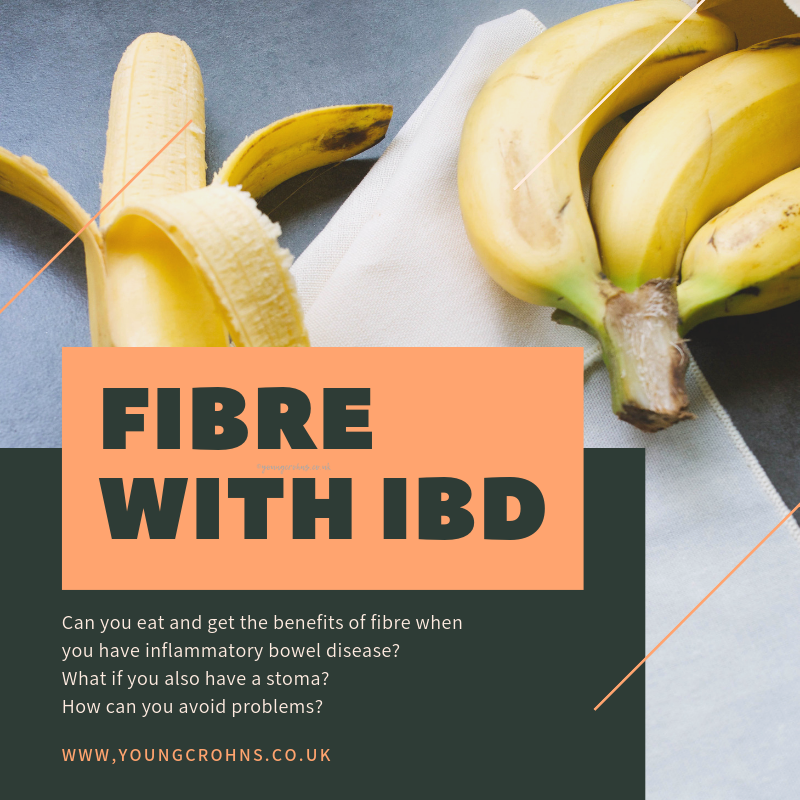
Fibre with IBD
Hands up who has been on the low residue diet in the months after diagnosis or surgery?
There would be very few people with their hands down because it has become the go to diet for those suffering from active inflammation of their condition. Rightly so too; imagine the red, irritated and painful lining of your bowel as you allow rough and fibrous food through it. It isn’t going to be happy and nor are you – the consequences can be frequent and sometimes bloody diarrhoea, vomiting, bloating, blockages and obstructions; sometimes leading to emergency surgery.
So, why am I talking to you about fibre when it is the antichrist in our IBD lives?
In The role of dietary fibre in inflammatory bowel disease paper (linked below in ‘further reading’) they explain that ” it is commonly observed that patients with IBD are permanently on a low-fibre diet, regardless of disease activity. The European Crohn’s and Colitis Organisation (ECCO) emphasise[d] that continuation of a regular diet is recommended during mildly to moderately active disease, both in UC and CD patients. The fibre-restricted diet should always be used only on a temporary basis”

While a bland, soft and beige diet is good for when we flare up and require bowel rest, what happens when we are back to somewhat better nutritional stand point? When we go to reintroduce food groups, can we add in fibre? If so, when and how?
Of the main types of dietary fibre, the most important, from a physiological point of view, are water soluble and water insoluble dietary fibres. Soluble fibre is a type of fibre that dissolves in water. It attracts the water to form a viscous gel and slows the colonic transit time. Almost all of soluble fibres are completely fermented in the large bowel. Water-insoluble fibre is more difficult to digest as it pulls water into the gut and makes food move more quickly through the gut.
Consuming insoluble fibre can aggravate IBD symptoms by causing more bloating, diarrhoea, gas and pain. And when there is severe inflammation or narrowing, consuming insoluble fibre can lead to worsening symptoms and a blockage in the intestinal tract.
More questions come, such as:
Can you eat and get all the benefits from fibre when you have Inflammatory Bowel Disease?
Simple answer: Yes.
Complex answer: Yes, but remember the following:
Healthy adults should eat 30g of fibre each day. Children under 16 need between 15g and 25g, depending on their age. In a person with a colon, fibre is essential in preventing constipation and keeps a person “regular”. This is the main function of fibre. Another theory about fibre is that it promotes mucosal growth, thus keeping the intestines healthier, promoting gut function. Of course, with IBD we can experience periods of intestinal inflammation due to our overactive immune responses; so it is important to bear in mind just how much fibre we consume and how.
Its worth speaking to a dietician before cutting down or changing the fibre in your diet so you don’t miss out on important health benefits. For example, they may suggest that some people cut down on fibre for a short time during a flare- up, before slowly adding it back in to the diet.
And if you’re trying to eat more fibre, increase the amount gradually to avoid bloating, wind and stomach cramps. Fibre attracts water so it’s important to drink eight to ten cups of fluid a day to avoid getting dehydrated. Water, milk and herbal teas are healthier than sugary or fizzy drinks.If you have Crohn’s you may develop a stricture, which is a narrowing in the small intestine. If you’ve had strictures or blockage episodes, your dietician or IBD team may recommend a low-fibre diet. This is to avoid fibre getting stuck in narrow parts of the bowel, which may increase the risk of a blockage.
What if you also have a stoma?
Again, simple answer: Yes.
Complex answer: bear in in mind your own stoma. Fibre discussed her is for those with an ileostomy – a stoma formed from the ileum, when the entire colon is removed. Important to note that difference here.
Whether or not to include fibre, and to what extent, should be based on personal tolerance of foods. The intestine has a remarkable capacity to adapt. Digested food in the small intestine is quite watery, and after it moves into the large intestine, a good portion of the water is reabsorbed into the body. Most fibre is indigestible material (from plants) that acts like a sponge, soaking up water and increasing the bulk of the intestinal contents making matter move through the system more quickly.
However, another type of fibre – soluble – may be beneficial to the ileostomies. The function of soluble fibre is to make intestinal contents “thicker” and can actually prevent diarrhoea. This fibre is found in oatmeal, barley, dried beans, peas, and the pulp of fruits and vegetables. Most foods have a combination of both types of fibre, but the above examples show the differences.
How can you avoid problems?
Usually a person without a colon doesn’t have a problem with constipation and may have mostly watery stools or diarrhoea. Over time, a person may adapt, especially if the last section of the small bowel (ileum) is still intact. So, consuming too much fibre, or too much “insoluble” fibre, may aggravate a person’s diarrhoea or watery stools. If this is the case, limiting insoluble fibre such as bran, popcorn hulls, seeds, nuts, skin/seeds, stringy parts of fruits and vegetables may be helpful.
It is about balance and this is a trial and error sort of experiement. While advise is usually given to new ostomates upon recovering from surgery when the bowel has been manipuated, handled and is swollen; yes a low fibre and low residue diet is fundemental to ensure the bowels are functioing well before dietary changes are made.
Even when they are made, the should be made slowly and carefully, in conjunction with a dietician, if possible. Avoiding blockages or obstructions are really key in early stoma life, but so is also managing the output consistency. While some stoma care nurses advocate for medication to help aid this, diet can also play a role too.
Conclusions?
Existing IBD guidelines from the Academy of Nutrition and Dietetics (formerly the American Dietetic Association), World Gastroenterology Organisation, and the Crohn’s & Colitis Foundation of America, regarding fibre intake, are very cautious: they all agree that dietary fibre consumption should not be limited in IBD patients in remission (except patients with strictures of the bowels).
Do you have any questions or queries? Or just want to share your own experiences?
You can leave me a reply here or leave comments via my social media accounts – on Twitter, find my blog page on Facebook and over on Instagram

If you enjoyed this post check out IBD v IBS – Why Do So Many Get Misdiagnosed , The Liver & IBD and The What & Why: Dehydration
Further Reading:
- PMC – The Role of Dietary Fibre in Inflammatory Bowel Disease – July 2015
- Crohn’s and Colitis UK – Publication – Food [pdf]
- Crohn’s Colitis Foundation of America – Diet, Nutrition and Inflammatory Bowel Disease [pdf]
- University of California, San Francisco [UCSF] Health – Nutrition Tips for Inflammatory Bowel Disease
- The Lancet Gastroenterology and Hepatology – The Low-Fibre Diet: Contender in IBD or has it had it’s time? – May 2019
- British Nutrition Foundation – Dietary Fibre
- Mayo Clinic Cleveland – Dietary Fibre: Essential for a Heathy Diet
- Oncology Nutrition – Constipation, Diarrhea and Fibre
- Colostomy UK – Diet
- Oxford University Hospital (OUH) – Dietary Requirements for people with an ileostomy [patient leaflet]
- Bladder and Bowel Community – Diet and Exercise with a Stoma





1 Comments
"Does caffeine affect your IBD?" •
17/03/2021 at 09:30
[…] enjoyed this post check out Fibre with IBD and The What and Why: […]